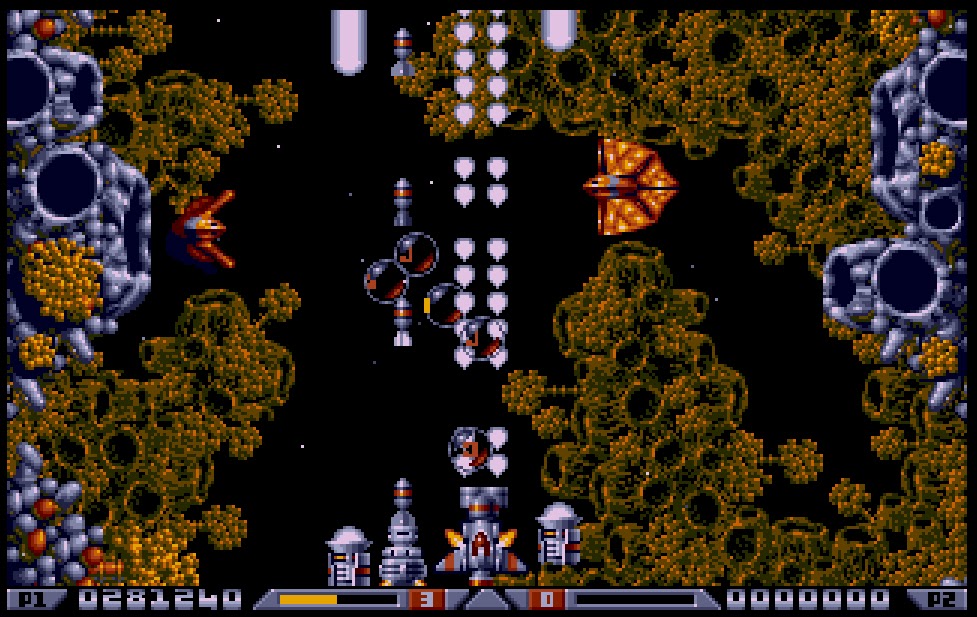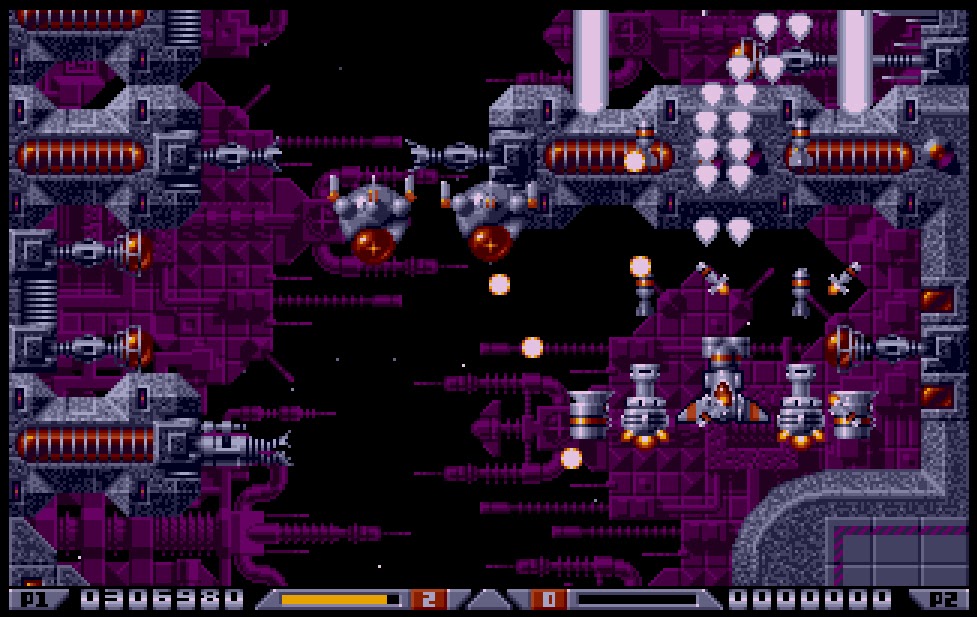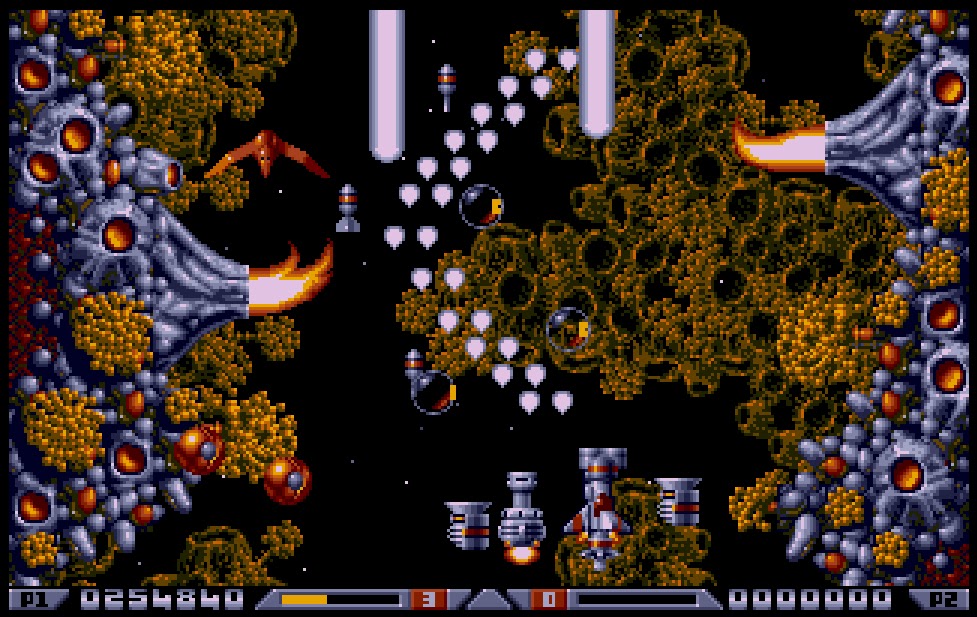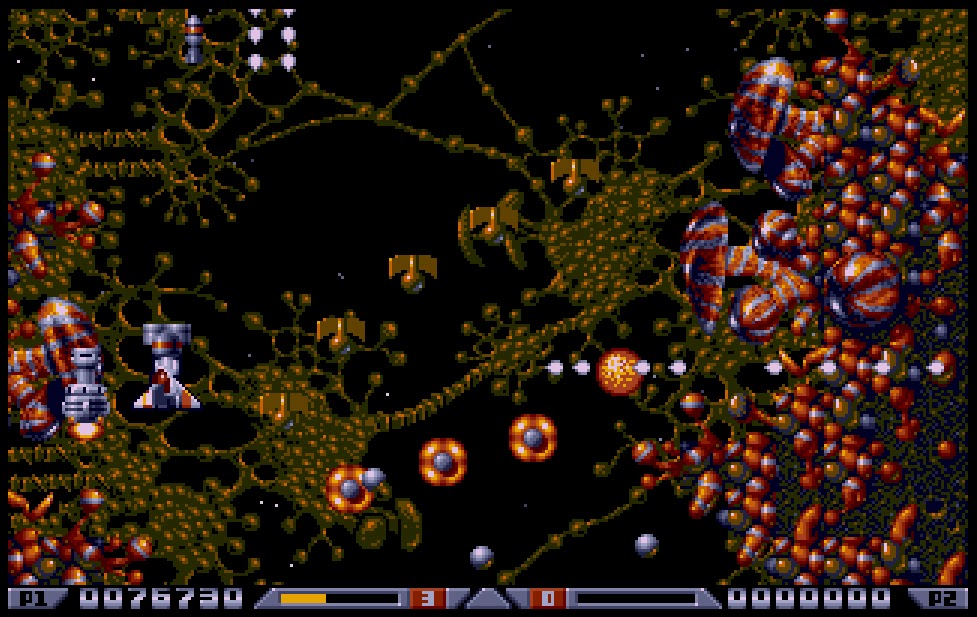After Xenon, the Bitmap Brothers released the decent (though completely overshadowed by its sequel) futuristic sports game, Speedball. They then went about designing a follow up for their debut game. With Xenon 2 Megablast the Bitmaps decided to forego their usual metallic looking graphics and instead went for an organic theme for all but the final level.
The best versions were for the 16-bit Commodore Amiga and Atari ST Atari ST
The wafer thin plot says the defeated antagonists from the
first game, the Xenites, are trying to wipe out the players history. To this end they have planted bombs in
several time zones. It is up to you to conquer
these zones - for some reason each bomb is diffused by destroying an end of level boss. Needless to say the plot
is not mentioned again in game.
Xenon 2 is set over several vertically
scrolling levels, each with a particular theme (underwater, insects, dinosaurs, technological). As well as the gorgeous
graphics the game features three layers of smooth parallax scrolling. Unusually your space craft has reverse thrust
to allow you to back up a limited distance. This
comes in especially useful where sections of scenery have dead ends and when tackling particular bosses.
 |
| Reverse thrust can also be useful for slowing the game and regulating the appearance of enemies or, as in this case, reaping money from the endless supply of flying squirrels. |
The scenery scrolls by slowly but the enemies come in thick and
fast. When waves of smaller enemies, or
certain larger enemies, are shot they drop a bubble. The smaller bubbles are worth 50 credits and the
larger ones are worth 100 credits. The
credits can be spent at the mid and end of level upgrade shop. Upgrades can be bought as well as sold and must
be picked up wisely as some weapons can’t be used together (eg side and rear
lasers) and certain weapons are more effective on particular levels. Some of the weapons can be upgraded several
times to increase their firepower. A
couple of the items are effectively useless such as the Bitmap Shades (dims the
screen) and Super Nashwan Power (gives you all the weapons but they are so short-lived
they are gone before any enemies appear). As well as weapons you can also purchase health and extra lives.
Additional upgrades occasionally appear during the level in the
form of pods. Shooting the pod reveals
the upgrade to be collected. At the
start of one level several side lasers can be picked so it is worth remembering
to sell any side or rear lasers you already possess for extra cash.
If your ship is hit by an enemy or their bullets you lose
energy. This can be replenished at the
upgrade shop or by collecting a health pickup when one appears. If the energy bar disappears completely you
lose a life and restart at one of the many checkpoints with upgrades still intact.
Bosses appear at the end of each level and most have a
mid level boss. These bosses are
suitably large and, again, are very impressive in terms of graphics for the
Amiga and ST. Each boss has obvious
weak points and drops a lot of credit bubbles when destroyed. These have to be collected quickly before
they drop off the screen.
Xenon 2 Megablast has been criticised for being too
hard. The Bitmap Brothers purposely did
not want to make an easy game and in fact went out of their way to make it more
difficult. A common feature on many
joysticks in the 80s was an autofire switch which took the pain out of a lot of
shooters. The Bitmap Brothers used some kind of
programming trickery which disabled these and even went as far as creating
a less effective autofire as a power up.
Little did they count on my cheap but fragile Cheetah Mach 1+
joystick. I had mainly used it as a second
stick for two player games and was the only one I could find where autofire
worked in Xenon 2. It had weak microswitches so I had to buy a
second stick and used the first one as spares when they failed. If it wasn’t for the Mach 1+ I would now have
a stump where my left thumb should be.
As I said, the game is very difficult and to get anywhere near
completing Xenon 2 you will need either
a bionic trigger finger or a (working) autofire joystick. Other criticisms? The game is exactly the same each time you
play it – power ups and enemies appear in the exact same places so it can turn
into a memory game. Having said that, Xenon 2 Megablast has to be one of my
all time favourite shooters - better than a lot of the excellent titles I have
already featured on the blog. It’s loud,
good looking, has great gameplay, numerous power-ups and is polished to the nth
degree – everything I look for in a shoot 'em up.
Example gameplay - music off, autofire on
 |
| The final level, the only one not to have organic looking graphics. |
Example gameplay - music off, autofire on






No comments:
Post a Comment